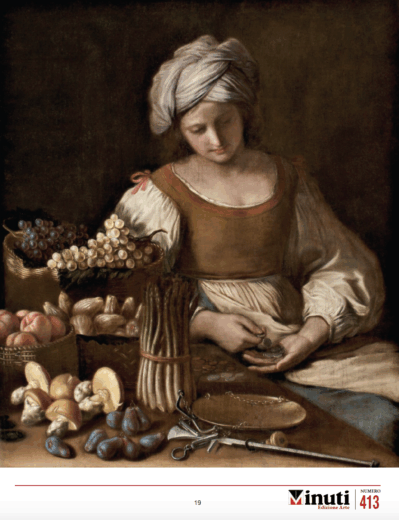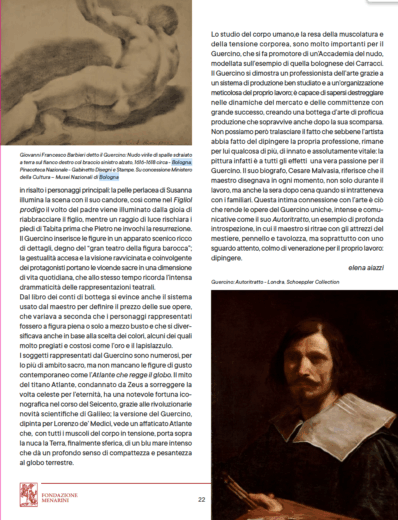Guercino and the soul of the workshop: passion, craftsmanship, and modernity

Issue 413 of Minuti Art Edition, the magazine curated by Fondazione Menarini, takes us on a journey to discover Giovanni Francesco Barbieri, better known as Guercino: one of the most captivating figures of 17th-century Italian painting. An artist who masterfully combined inspiration and discipline, art and business, achieving a balance that still impresses today for its modernity and managerial clarity.
The workshop as a forge of beauty
 In the seventeenth century, artist workshops were not merely places of work: they were true laboratories of creativity. These were spaces of constant study, experimentation, and drawing. Such was the case for Guercino’s workshop, first established in Cento, his hometown, and later relocated to Bologna. The studio was run with an almost corporate structure: drawings, sketches, bookkeeping, apprentices, and commissions from across Europe. The posthumous inventory of his workshop speaks volumes: over five thousand sheets, more than half of which were drawn by his own hand. An astonishing volume that underscores the central role of drawing as both a design and learning tool.
In the seventeenth century, artist workshops were not merely places of work: they were true laboratories of creativity. These were spaces of constant study, experimentation, and drawing. Such was the case for Guercino’s workshop, first established in Cento, his hometown, and later relocated to Bologna. The studio was run with an almost corporate structure: drawings, sketches, bookkeeping, apprentices, and commissions from across Europe. The posthumous inventory of his workshop speaks volumes: over five thousand sheets, more than half of which were drawn by his own hand. An astonishing volume that underscores the central role of drawing as both a design and learning tool.
Giovanni Francesco worked closely with his brother Paolo Antonio, a specialist in still life. A famous example of their collaboration is the painting Ortolana, a perfect demonstration of their four-handed artistry: Paolo painted the fruit, while Guercino rendered the female figure, absorbed in shadow and brimming with realism.
Art and the market: painting as a craft
Guercino skillfully navigated the world of commissions. His account book—preserved in its entirety—is a valuable document that records every artwork, client, and fee. It features prestigious names: Pope Gregory XV, Maria de’ Medici, Charles I of England, and the Dukes of Este. Each piece was priced according to specific criteria: full figure or half-length, the use of rare pigments such as gold or lapis lazuli.
Among the most powerful paintings stand out Susanna and the Elders, The Return of the Prodigal Son, The Raising of Tabitha, and Lot and His Daughters. Works in which light plays a theatrical role, illuminating faces and gestures in stage-like compositions that prefigure the dramatic intensity of the Baroque.
A tireless artist
 But beyond the structure and the success, what strikes us most about Guercino is his boundless passion. He was always drawing—by day, by night, even in the company of his family, as his biographer Cesare Malvasia recounts. He even founded a Nude Academy, inspired by the Carracci model, to perfect the study of the human form.
But beyond the structure and the success, what strikes us most about Guercino is his boundless passion. He was always drawing—by day, by night, even in the company of his family, as his biographer Cesare Malvasia recounts. He even founded a Nude Academy, inspired by the Carracci model, to perfect the study of the human form.
This dedication comes through in his Self-Portrait: a penetrating, proud, and focused gaze. He holds a brush and palette, but what truly captures us is the emotional intensity of his eyes. For Guercino, painting was not just a job—it was a calling, a way of life.
Thus, this article offers us a vivid portrait of Guercino: artist, master, and manager before his time. His workshop, built with both passion and method, is a powerful example of how art can flourish when talent and organization go hand in hand.
Discover all the publications by Minuti Art Edition and let yourself be inspired by a rich and accessible cultural heritage. If you are a doctor or pharmacist, you can subscribe to Minuti Art to receive the print version free of charge.
Subscribe on the Fondazione Menarini website to stay updated: https://fondazione-menarini.com/it/area-riservata.html
You can find all Minuti Art Edition issues at this link: https://www.fondazionemenarini-minuti.com/edizione-artistica/?lang=en
